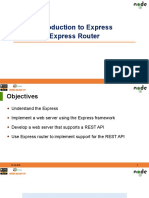5_Intro to Backend Development with nodejs.
md 2024-10-27
Session 5: Introduction to Backend Development with
Node.js
1. Introduction to Node.js
What is Node.js?
A JavaScript runtime built on Chrome's V8 engine.
Enables full-stack development by allowing JavaScript to be used for both frontend and backend.
Why Node.js?
Non-blocking, event-driven architecture: Efficiently handles I/O-heavy tasks.
Extensive ecosystem: npm provides over a million libraries for rapid development.
2. Setting up Node.js and npm
Steps:
1. Install Node.js from the official website.
2. Verify the installation:
node -v
npm -v
3. npm: Node Package Manager for managing project dependencies.
3. Building a Simple Server with Express.js
What is Express.js?
A minimal framework for building web apps and APIs with Node.js.
Create a Basic Server
1. Initialize a new project:
mkdir my-first-server
cd my-first-server
npm init -y
2. Install Express:
1/3
�5_Intro to Backend Development with nodejs.md 2024-10-27
npm install express
3. Create a simple server in index.js:
const express = require("express");
const app = express();
const port = 3000;
app.get("/", (req, res) => {
res.send("Hello, World!");
});
app.listen(port, () => {
console.log(`Server running on http://localhost:${port}`);
});
4. Run the server:
node index.js
Visit http://localhost:3000 in a browser.
4. Hands-on Exercise: Creating a RESTful API with Node.js
Task: Build a Simple RESTful API
1. Define routes in index.js:
const express = require("express");
const app = express();
const port = 3000;
app.use(express.json());
let users = [
{ id: 1, name: "Alice" },
{ id: 2, name: "Bob" },
];
// GET all users
app.get("/users", (req, res) => {
res.json(users);
});
// GET a user by ID
2/3
�5_Intro to Backend Development with nodejs.md 2024-10-27
app.get("/users/:id", (req, res) => {
const user = users.find((u) => u.id == req.params.id);
user ? res.json(user) : res.status(404).send("User not found");
});
// POST a new user
app.post("/users", (req, res) => {
const newUser = { id: users.length + 1, name: req.body.name };
users.push(newUser);
res.status(201).json(newUser);
});
// DELETE a user by ID
app.delete("/users/:id", (req, res) => {
users = users.filter((u) => u.id != req.params.id);
res.status(204).send();
});
app.listen(port, () => {
console.log(`Server running on http://localhost:${port}`);
});
2. Test the API:
Use tools like Postman to test GET, POST, and DELETE endpoints.
5. Discussion: The Role of Node.js in Modern Web Development
Why Use Node.js?
Scalability: Ideal for real-time apps like chat apps or games.
Efficiency: Handles many requests simultaneously due to its non-blocking model.
Common Use Cases
Real-time applications: Chat, multiplayer games.
Streaming services: Video streaming apps.
REST APIs: Often used in microservices architectures.
6. Homework Assignment
Extend your API to handle PUT requests for updating users.
Add error handling for when a user isn't found.
3/3





















































































